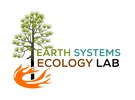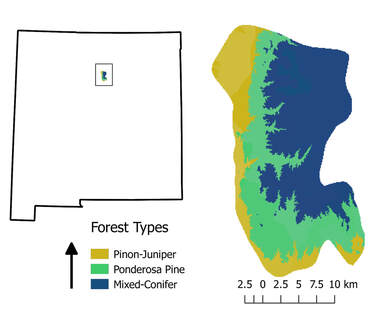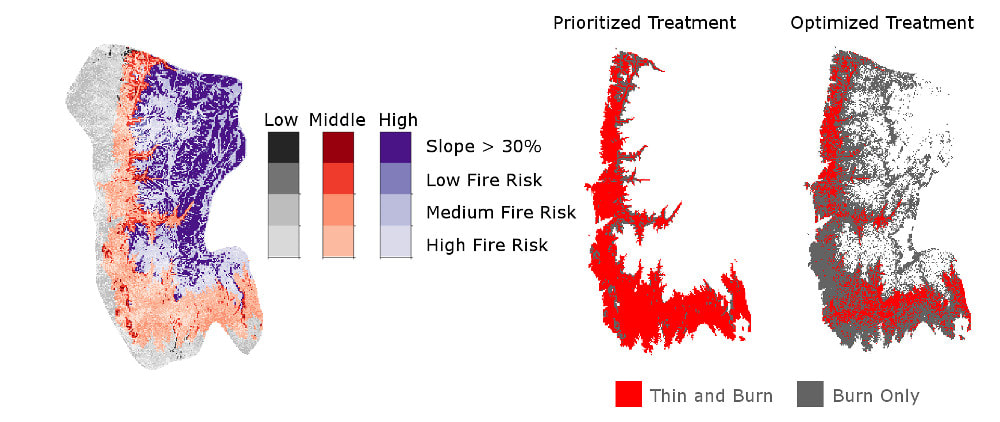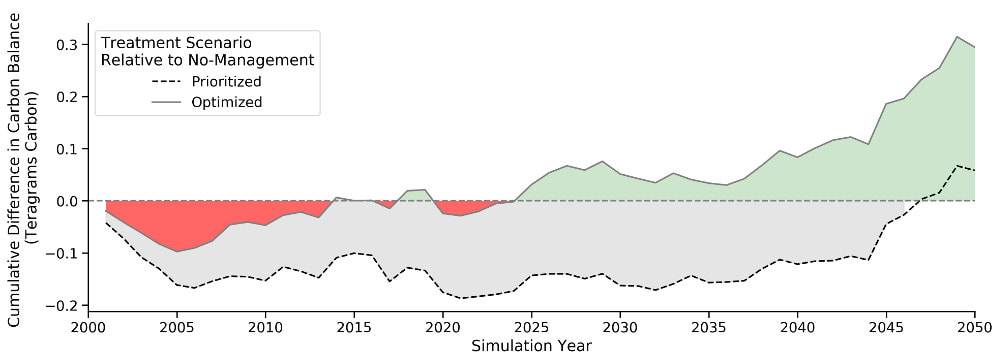|
The area burned by wildfire in the southwestern US has increased by over 400% since the 1980s. While many of the forests in the southwest are adapted to deal with frequent-fire, we’ve had a long fire-free period because of fire suppression. This has allowed forests to grow dense and fuels to increase. As a result, we are now seeing increased area burned by large, hot, tree-killing fire, which is uncharacteristic for many southwestern forest types. This is problematic for a number of reasons, but becomes especially problematic when a large, hot wildfire burns through a watershed that serves a community. The Santa Fe Fireshed is approximately 111,000 acres and encompasses the City of Santa Fe’s municipal watershed. The Santa Fe Fireshed Coalition is a collaborative group working to develop and implement management strategies to reduce the chance that a large, hot fire impacts the municipal watershed. In a recent study led by Dan Krofcheck, we ran simulations to quantify the effects of different management options on fire severity and carbon dynamics in the Fireshed under future climate and future fire weather. We used the Fireshed Coalition’s implemented, planned, and proposed treatments to develop and simulate a treatment scenario we called the prioritized scenario. We also ran a series of simulations without management (No-Management) to identify the areas with the greatest risk of tree-killing fire. We used these scenarios to develop the optimized scenario. The optimized scenario differs from the prioritized scenario by only thinning the areas with the largest chance of burning at high-severity and increasing the area that is only treated with prescribed fire. We then ran simulations using future climate from different climate models, ending with a total of 6250 simulation years of data for each management scenario (No-Management, Prioritized, Optimized). We compiled all of the data for each scenario to determine if the optimized scenario was as effective as the prioritized scenario at reducing high-severity fire. We found that it was actually a bit more effective because the area that was treated with prescribed burning was expanded to include dry mixed-conifer forest. We also looked at the effects of these different scenarios on carbon, because forests are important for helping to regulate the climate. Since thinning treatments reduce the amount of carbon stored in the forest and prescribed burning causes emissions of carbon to the atmosphere, we expected both treatment scenarios to cause the amount of carbon stored in the forest to initially decrease, relative to the no-management scenario. However, because the management scenarios decrease the amount of tree-killing fire, we expected that over time, the carbon stored on the landscape would increase relative to the no-management scenario. We found the while both management scenarios ended up storing more carbon by 2050, the optimized scenario carbon storage surpassed the no-management scenario in approximately 25 years. In fact, the optimized scenario ended up storing approximately 0.3 teragrams more carbon than the no-management scenario. That is equivalent to the annual carbon emissions from 15,000 average Americans. The reason that the optimized scenario carbon storage surpassed the no-management scenario twenty years earlier than the prioritized scenario is that we thinned less area in the optimized scenario. By only thinning areas with the largest chance of burning at high-severity, we reduced the thinned area by 54%. It is important to note that the only reason the optimized scenario was as effective as the prioritized scenario was because the area burned with prescribed fire increased by 27%. Our results suggest that in this southwestern landscape, restoring regular surface fire will provide more climate benefit than leaving the forests dense and running the risk that they will burn at high-severity.
0 Comments
|
Details
Archives
October 2023
Categories
All
|





 RSS Feed
RSS Feed